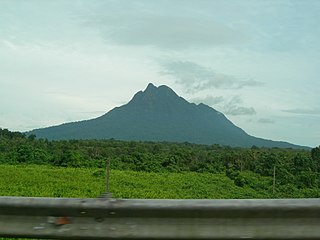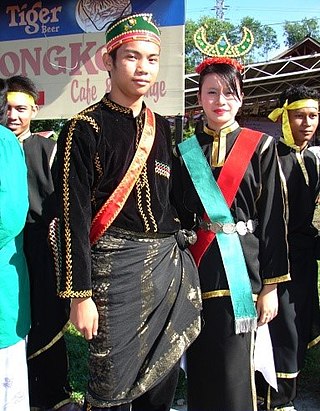Related Research Articles

Bidayuh is the collective name for several indigenous groups found in southern Sarawak, Malaysia and northern West Kalimantan, Indonesia, on the island of Borneo, which are broadly similar in language and culture. The name Bidayuh means 'inhabitants of land'. Originally from the western part of Borneo, the collective name Land Dayak was first used during the period of Rajah James Brooke, the White Rajah of Sarawak. At times, they were also lesser referred to as Klemantan people. They constitute one of the main indigenous groups in Sarawak and West Kalimantan and live in towns and villages around Kuching and Serian in the Malaysian state of Sarawak, while in the Indonesian province of West Kalimantan they are mainly concentrated in the northern Sanggau Regency. In Sarawak, most of Bidayuh population can be found within 40 km of the geographical area known as Greater Kuching, within the Kuching and Serian Division. They are the second-largest Dayak ethnic group in Sarawak after the Iban and one of the major Dayak tribes in West Kalimantan.

Lawas is a small town and the capital of Lawas District, Limbang Division, Sarawak, Malaysia. This district area is 3,811.90 square kilometres, and population was 46,200. It is 1,200 km from the state capital, Kuching and 200 km from the capital city of Sabah, Kota Kinabalu.

Kuching Division is one of the twelve administrative divisions in Sarawak, Malaysia. Formerly part of what was called the "First Division", it is the center and the starting point of modern Sarawak. Kuching Division has a total area of 4,559.5 square kilometres.

A village head, village headman or village chief is the community leader of a village or a small town.

Mount Santubong is a mountain in the Malaysian state of Sarawak. It is located about 35 km north of the state capital Kuching.

Dalat is the administrative town of the Dalat district in Mukah Division, Sarawak, Malaysia. It is situated by the Oya River.

Bau is a gold mining town, capital of Bau district in the Kuching Division of Sarawak, Malaysia.

Melanau or A-Likou is an ethnic group indigenous to Sarawak, Malaysia. They are among the earliest settlers of Sarawak. They speak the Melanau language, which is a part of the North Bornean branch of Malayo-Polynesian languages.

Bisaya is an indigenous people from the northwest coast of East Malaysia on the island of Borneo. Their population is concentrated around Beaufort as well as Kuala Penyu districts of southern Sabah, Labuan Federal Territory and in Limbang District, Sarawak. The Bisaya tribe has many similarities with the Dusun Tatana tribe, especially in terms of language. It is evident that some of their dialogical language conversations are almost identical if they have a dialogue with each other. Nowadays the Bisaya living in Sabah are Muslims, while the Bisaya living in Sarawak are mostly Christians. In Brunei, they are referred as Dusun, Jati Dusun and Bisaya. The Bisaya is closely related, linguistically, with the Tatana Dusun of Kuala Penyu, Sabah.

Betawi, also known as Betawi Malay, Jakartan Malay, or Batavian Malay, is the spoken language of the Betawi people in Jakarta, Indonesia. It is the native language of perhaps 5 million people; a precise number is difficult to determine due to the vague use of the name.

Serikin is a small Bidayuh town in Kuching Division, Sarawak, Malaysia. The town is located about 15 km from Bau town and 80 km from Kuching city. Serikin is located on the border of Indonesia and Malaysia. Serikin is called Kampung Jagoi Serikin by the local residents.

The Battle of Sungei Koemba took place during the Indonesia–Malaysia confrontation. Involving Australian and Indonesian troops, the battle consisted of a series of ambushes launched by the 3rd Battalion, Royal Australian Regiment, along the Sungei Koemba river in Kalimantan. The ambushes were part of the wider Operation Claret which involved cross-border operations by British-Commonwealth units from bases in Sarawak, penetrating up to 10,000 yards (9,100 m) into Indonesian territory with the aim of disrupting the movement and resupply of Indonesian forces and to keep them off balance.
The Land Dayak languages are a group of dozen or so languages spoken by the Bidayuh Land Dayaks of Borneo, and by some, also spoken by the Rejang people of southwestern Sumatra.

Kampung Mundai(Mundai Village) is one of the Bidayuh community settlement in Padawan area of Sarawak, Malaysia. It is located at Km 2, Jalan Padawan near a small town of Tapah, about 38 km from Kuching city centre. There are about 250 houses in the village.
Pulau Meranti is a village in Sepang District, Selangor, Malaysia.
Balai Ringin is a town, constituency and autonomous sub-district in Serian Division, Sarawak, Malaysia, about half an hour drive from Serian town along the Pan Borneo Highway.
Tondong is a settlement on the Sarawak Kanan river in the Bau district of Sarawak, Malaysia. It lies approximately 25.2 kilometres (16 mi) southwest of the state capital Kuching.
Sarawak's population is very diverse, comprising many races and ethnic groups. Sarawak has more than 40 sub-ethnic groups, each with its own distinct language, culture and lifestyle. This makes Sarawak demography very distinct and unique compared to its Peninsular counterpart. However, it largely mirrors to other territories in Borneo – Sabah, Brunei and Kalimantan.
Kendayan, or Salako (Selako), is a Malayic Dayak language of Borneo. The exact number of speakers remains unknown, but is estimated to be around 350,000.
Taee Village is a village in Serian, Sarawak. About 60 km from Kuching, Kampung Taee is situated directly at the foot of Mount Sadong, Serian. The village was moved and split into two villages, Kampung Taee and Kampung Plaman Nyabet. The village had a population of about 2200 people, the majority being Bidayuh, as well as Chinese, Malay, Iban & Indians. The language used there is Bidayuh Bukar.
References
- ↑ Jagoi at Ethnologue (18th ed., 2015) (subscription required)